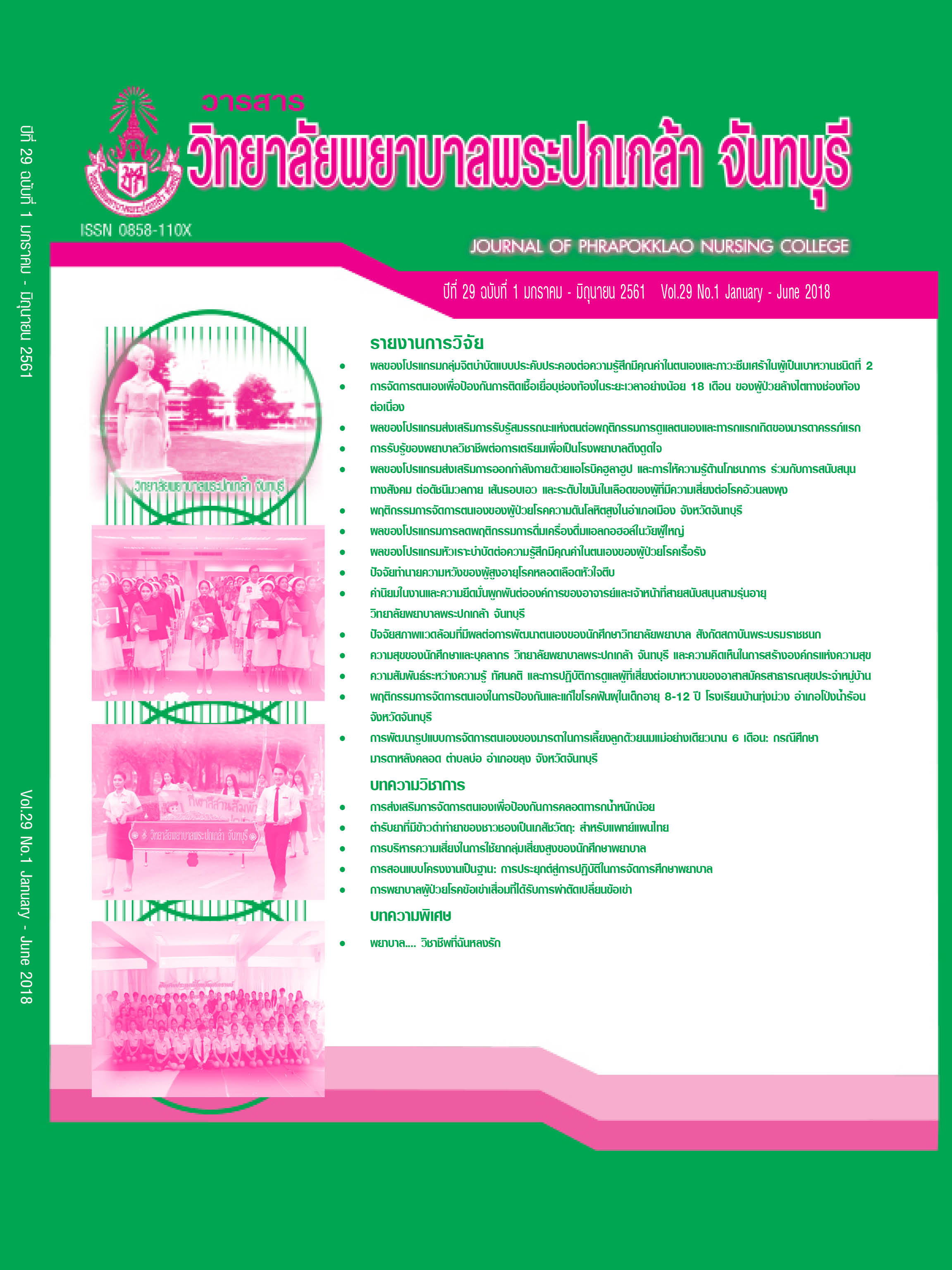Self-management Behaviors Regarding Dental Caries Prevention and Solving among 8-12 Years Children, Ban Thung Muang School, Pong Nam Ron District, Chanthaburi Province
Keywords:
Dental caries, Self-management behavior, Dental caries prevention, Dental caries solvingAbstract
This descriptive research aimed to determine self-management behaviors regarding dental caries prevention and solving among 8-12 years children, Ban Thung Muang School, Pong Nam Ron District, Chanthaburi Province. The samples consisted of 47 school age children with dental caries at Ban Thung Muang School. The research instrument was a self-management behavior questionnaire that comprised the demographic data; self-management behaviors in dental caries prevention with the reliability of .83, and self-management behaviors in dental caries solving with the reliability of .66. Data were collected in November 2015. Data were analyzed using frequency, percentage, mean, and standard deviation.
The research results revealed that the most participants had the score of self-management behaviors in dental caries preventions at a moderate level (89.40%), and the mean score of this behavior was at the moderate level (X = 2.60, SD = .28). Most students have dental plaque (78.70%) and had the self-management behaviors in dental caries solving at a moderate level (59.60%), as same as the mean score of this behavior was at the moderate level (X = 2.83, SD = .56).
This research suggested that the health care team who has the responsibility about the school health can use these results as a guideline for educating the prevention and treatments of dental caries, such as flossing used for the primary school children and promote self-management support by the teachers and parents.
References
ชดช้อย วัฒนะ. (2558). การสนับสนุนการจัดการตนเอง: กลยุทธ์ในการส่งเสริมการควบคุมโรค. วารสารวิทยาลัยพยาบาลพระปกเกล้า จันทบุรี, 26(เพิ่มเติม 1), 117-127.
ณรงศักดิ์ บุญเฉลียว. (2559). ผลของโปรแกรมทันตสุขศึกษาต่อการปรับเปลี่ยนพฤติกรรมการดูแลอนามัยช่องปากของนักเรียนชั้นประถมศึกษาปีที่ 6. วารสารวิทยาลัยพยาบาลพระปกเกล้า จันทบุรี, 27(เพิ่มเติม 1), 17-27.
ดำรงเกียรติ เกรียงพิชิตชัย. (2550). ความรู้ ทัศนคติ พฤติกรรม และปัจจัยที่มีความสัมพันธ์กับพฤติกรรมทันตสุขภาพของนักเรียนประถมศึกษาปีที่ 4-6 ในโรงเรียนประถมศึกษาแห่งหนึ่ง อำเภอบางสะพาน จังหวัดประจวบคีรีขันธ์. วารสารทันตาภิบาล, 19(3), 13-24.
ลักขณา อุ้ยจิรากุล. (2557). ปัจจัยที่สัมพันธ์กับการเกิดโรคฟันผุในเด็กปฐมวัย จังหวัดสระแก้ว. วารสารสำนักงานป้องกันควบคุมโรคที่ 3 จังหวัดชลบุรี, 5(2), 2-14.
วิลาวัลย์ วีระอาชากุล, และวิบูลย์ วีระอาชากุล. (2551). ปัจจัยที่มีความสัมพันธ์กับการเกิดโรคฟันน้ำนมผุในเด็กอายุ 6-30 เดือน ในคลินิกเด็กดี โรงพยาบาลศรีนครินทร์ คณะแพทยศาสตร์ มหาวิทยาลัยขอนแก่น. ศรีนครินทร์เวชสาร, 23(2), 165-171.
สำนักทันตสาธารณสุข กรมอนามัย กระทรวงสาธารณสุข. (2555). รายงานผลการสำรวจสภาวะสุขภาพช่องปากระดับประเทศ ครั้งที่ 7 พ.ศ. 2551-2555. กรุงเทพฯ: สำนักงานกิจการโรงพิมพ์องค์การสงเคราะห์ทหารผ่านศึก.
สิยาภา พนังแก้ว วัชรสินธุ์, เยาวภา ติอัชสุวรรณ, และสุรเดช ประดิษฐบาทุกา. (2557). ปัจจัยระดับบุคคลที่มีความสัมพันธ์กับสภาวะสุขภาพช่องปากของนักเรียนชั้นประถมศึกษาปีที่ 6 ในอำเภอดอนสัก จังหวัดสุราษฎร์ธานี. ใน รายงานสืบเนื่องจากการประชุมเสนอผลงานวิจัยระดับบัณฑิตศึกษา มหาวิทยาลัยสุโขทัยธรรมาธิราช ครั้งที่ 4. หน้า 1-17. วันที่ 26-27 พฤศจิกายน 2557 ณ มหาวิทยาลัยสุโขทัยธรรมาธิราช.
อรพินท์ ภาคภูมิ, และกันยารัตน์ สมบัติธีระ. (2554). การสำรวจสภาวะสุขภาพเด็กวัยเรียนในเขตตรวจราชการที่ 10 และ 12. วารสารศูนย์อนามัยที่ 6 ขอนแก่น, 2, 37-48.
American Academy of Pediatric Dentistry. (1999). Oral health policies. Pediatric Dentistry, 21, 18-37.
Creer, L. T. (2000). Self-management of chronic illness. In Boekaerts, M., Printrich, P. R., & Zeidner, M. (Eds.). Handbook of self-regulation. pp. 601-629. San Diego, CA: Academic Press.
Febres, C., Echeverri, E. A., & Keene, H. J. (1997). Parental awareness, habit, and social factors and their relationship to baby bottle tooth decay. Pediatric Dentistry, 19(1), 22-27.
Glomb, N., & West, R. P. (1990). Teaching behaviorally disordered adolescents to use self-management skills for improving the completeness, accuracy, and neatness of creative writing homework assignments. Behavioral Disorders, 15(4), 233-242.
Locker, D. (2007). Disparities in oral health related quality of life in a population of Canadian children. Community Dentistry and Oral Epidemiology, 35(5), 348-356.
Ward, W. C. (2006). Teaching children to self-manage their behavior. Retrieved May 12, 2017, from https://www.superduperinc.com/handouts/pdf/113_SelfManagingBehavior.pdf
Downloads
Published
How to Cite
Issue
Section
License
Copyright (c) 2018 Journal of Phrapokklao Nursing College

This work is licensed under a Creative Commons Attribution-NonCommercial-NoDerivatives 4.0 International License.
เนื้อความ ข้อมูล และรายการอ้างอิงที่ผู้เขียนใช้ในการเขียนบทความเพื่อลงตีพิมพ์ในวารสารวิทยาลัยพยาบาลพระปกเกล้า จันทบุรี ถือเป็นความคิดเห็นและความรับผิดชอบของผู้เขียน คณะผู้จัดทำวารสารไม่จำเป็นต้องเห็นพ้องด้วยหรือร่วมรับผิดชอบ
บทความที่ได้รับการลงตีพิมพ์ในวารสารวิทยาลัยพยาบาลพระปกเกล้า จันทบุรี ถือเป็นลิขสิทธิ์ของวารสารวิทยาลัยพยาบาลพระปกเกล้า จันทบุรี หากหน่วยงานหรือบุคคลใดต้องการนำส่วนหนึ่งหรือทั้งหมดของบทความไปเผยแพร่ต่อเพื่อวัตถุประสงค์ใด ๆ จะต้องได้รับอนุญาตจากบรรณาธิการวารสารก่อน



